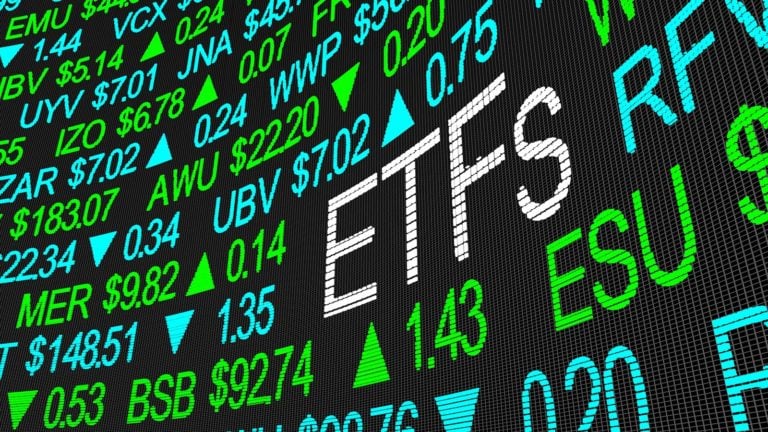With over $4 trillion in domestic assets allocated to exchange traded funds and more than 2,000 exchange traded products (ETFs and ETNs) trading on U.S. exchanges, its fair to say plenty of investors are embracing ETFs.
Data also confirm the ETF market is booming. Bank of America recently said the ETF industry could top a stunning $50 trillion by 2030.
“The current growth rate points to ETF assets approaching $50tn over the next decade driven by a continued move to passive and increased awareness of the attractive tax efficiency, cost, liquidity and transparency characteristics of ETFs,” BofA said in a note out in December.
Of course, there are plenty of good ETFs out there and some that could prove to be regrettable choices, regardless of how long they’ve been in the game.
For investors new to the world of ETFs, here are some of the best funds to consider.
Invesco QQQ (QQQ)

Expense ratio: 0.20% per year, or $20 on a $10,000 investment.
Home to $87 billion in assets under management, the Invesco QQQ (NASDAQ:QQQ) is one of the world’s largest ETFs that doesn’t hail from the iShares or Vanguard families. QQQ is one of the best funds for new ETF investors, particularly those on the younger side with long time horizons, because it offers broad-based, cost-effective exposure to many storied communication services and technology companies.
For example, QQQ allocates over 30% of its combined weight to Apple (NASDAQ:AAPL), Microsoft (NASDAQ:MSFT) and Amazon (NASDAQ:AMZN). With a 47.30% weight to tech stocks, QQQ is one of the best funds for investors that want to overweight that sector with the commitment of a dedicated technology ETF.
Then there is the long-term performance of the Nasdaq-100 Index, which, to put things simply, has been jaw-dropping.
As of Dec. 13, 2019, “on a cumulative price return basis, the NASDAQ-100 Index has returned almost 6,673.51% since inception (January 1985), although past performance is not indicative of future performance,” according to Nasdaq.
Vanguard Small-Cap Value ETF (VBR)

Expense ratio: 0.07%
Conventional wisdom often dictates that for new investors, the best funds are broad market ETFs and index funds that feature exposure to a massive number of stocks. That wisdom usually says there’s small-cap exposure in those funds. That’s correct, but total market funds typically generate returns that are comparable to the S&P 500 or Russell 1000 indexes because smaller stocks have tiny weights in those products.
What that means is that investors should isolate the size factor and do it in cost-effective fashion with ETFs such as the Vanguard Small-Cap Value ETF (NYSEARCA:VBR). A slew of academic and industry research supports the notion that not only do small caps outperform larger stocks over time, but that small-cap value beats small-cap growth.
“Findings show that the size effect has been concentrated in the month of January and that small-cap stocks are riskier than large-cap stocks,” according to the Journal of Financial Planning. “There is economic logic to suggest the small-cap outperformance evidences a risk premium. Small value has outperformed small growth stocks on an absolute basis.”
The $14.4 billion VBR is one of the best funds for investors looking to address the small-cap value proposition and features a deep bench of 854 stocks. This Vanguard product allocates a combined 57.4% of its weight to financial services and industrial stocks.
With smaller and value stocks having lagged for several years, VBR could be one of the best funds for investors of all stripes to consider in 2020, assuming value stocks get their respective acts in gear.
iShares Core MSCI Emerging Markets ETF (IEMG)

Expense ratio: 0.14%
New investors, particularly those with time on their side, should embrace emerging markets equities, an asset class that spent much of the last decade lagging U.S. equities. Some market participants are wagering that trend will reverse, perhaps as soon as this year, indicating that the cost-effective iShares Core MSCI Emerging Markets ETF (NYSEARCA:IEMG) merits consideration.
Even as emerging markets lagged, IEMG has been one of the most prolific asset-gathering ETFs over the past several years, becoming the second-largest fund in its respective category. The nearly $62 billion IEMG holds almost 2,500 stocks, making it one of the best funds when it comes to emerging markets diversification, at least at the components level.
Geographically speaking, IEMG presents some concentration risk as China, Taiwan and South Korea combine for 56% of the fund’s weight. Fortunately, President Donald Trump appears intent on repairing the trade relationship with China and the Fed Reserve is unlikely to raise rates in 2020.
“A final issue for so-called emerging markets will be their equity market valuations,” reports the South China Morning Post. “As matters stand, emerging-market equities are generally inexpensive – and, by some measures, quite attractive – relative to equity and bond markets globally. If Trump decides to play nice, the Fed remains a benign influence and China stabilises its annual growth rate just below 6 per cent, emerging-market equities could do rather well in 2020.”
As of this writing, Todd Shriber did not own any of the aforementioned securities.
